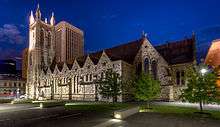St Francis Xavier's Cathedral, Adelaide
St Francis Xavier's Cathedral is a Roman Catholic cathedral in Adelaide, South Australia. It is classified as being a Gothic Revival building in the Early English style. The tower stands 36 m high and is 56.5 m lengthwise and 29.5 m horizontally. The foundation stone was laid in 1856 and the building was opened in 1858. The construction of the tower began in 1887. However, it was not completed until 1996.
| St Francis Xavier's Cathedral, Adelaide | |
|---|---|
 The cathedral at night | |
| Religion | |
| Affiliation | Roman Catholic |
| District | Metropolitan Archdiocese of Adelaide |
| Ecclesiastical or organizational status | Cathedral[1] |
| Leadership | Vacant |
| Year consecrated | 11 July 1858 (Stage 1) 18 April 1926 (Stage 2) 11 July 1996 (Stage 3) |
| Location | |
| Location | Adelaide, South Australia, Australia |
| Geographic coordinates | 34°55′44″S 138°36′05″E |
| Architecture | |
| Architect(s) | Richard Lambeth, Charles Hansom, Peter Paul Pugin, Lynton Jury |
| Type | Church |
| Style | Gothic Revival |
| Groundbreaking | 17 March 1856 |
| Completed | 11 July 1996 |
| Height (max) | 36 metres |
| Website | |
| adelcathparish.org | |
History
In 1838, two years after the proclamation of South Australia, an advertisement was put up to organise religious meetings for South Australian Catholics. The first Mass was celebrated in a house on East Terrace in 1840. In 1845, a Catholic primary school was set up and used as the religious centre for Catholics until the foundation stone for a cathedral was laid in 1851 for a design by Richard Lambeth. However, with a gold rush in Victoria, Lambeth left along with many of the population, leaving no plans and with the community in economic depression.[2]
The original foundation stone was put in place on 17 March 1856 by the vicar general, Father Michael Ryan, with the first part of the cathedral being dedicated on 11 July 1858. It was first extended when construction began at the southern end of the cathedral, including the sanctuary, side chapel, lady chapel and sacristy in January 1859. Construction of the first extension finished the following year in November 1860. With further growth in the population of Adelaide, another extension was required to seat more worshippers. In November 1886, Bishop Reynolds laid the foundation stone for an extension on the eastern side for a further 200 people, as well new vestries and confessionals. These were completed in August the following year. In 1904, electric lighting was introduced.
The cathedral was expanded again in 1923, with extensions to the western aisle and northern end of the bell tower, and was opened in April 1926 by Archbishop Spence. The cornerstone of the current bell tower was laid in 1887, and although the lower part was built between 1923 and 1926 it was not completed until 1996 by the architect Lynton Jury, 109 years after construction of the tower commenced. The bell used in the tower is the Murphy Bell of 1867, surrounded by thirteen other bells hung for change ringing, installed in 1996, seven of these bells date from 1881 and were previously in St Mary's Cathedral, Sydney.[3][4][5] The bells are rung by members of The Australian and New Zealand Association of Bellringers.[6] The cathedral suffered significant damage in the 1954 Adelaide earthquake.[7]
Features
Located at the north-western corner is a statue of St John the Baptist, which was carved in Tuscany in 1925 and features a picture of the baptism of Jesus. The lady chapel altar, located at the south-west, is made from Carrara marble with inset panels of simulated lapis lazuli (although many texts erroneously describe it as real) and was dedicated in 1954. Bronze statues of Joseph and Jesus and the flight into Egypt are also depicted on the western side of the cathedral. At the front of the cathedral, the southern end, are lancet windows featuring images of St Patrick and St Lawrence, as well depictions of the life of Mary and Jesus. The eastern side of the cathedral features a statue of St Patrick, the patron of the Archdiocese of Adelaide, with Celtic symbols prevalent in the surroundings.[3]
The cathedral has had three organs throughout its history. The first was put in place in 1869 by Johann Wolff, with two pedals and one manual. It was replaced in 1926 by J. E. Dodd with two manuals, which was subsequently rebuilt in 1954.[8]
Services
The cathedral is open daily from early morning until evening, with Mass celebrated three times daily. The cathedral also maintains a choir.[9]
Gallery
 The cathedral in 1863
The cathedral in 1863 View from Victoria Square
View from Victoria Square- Front aspect (across Wakefield St)
 Night view
Night view Tower
Tower- Interior
References
- "St Francis Xavier's Cathedral". GCatholic.org. 15 January 2012. Retrieved 3 February 2012.
- "History 1844-1860". St Francis Xavier's Cathedral. Archived from the original on 14 October 2006. Retrieved 28 November 2006.
- 10 Minute Cathedral Tour - Explore St. Francis Xavier's Cathedral Adelaide. 2005.
- "The Cathedral Bells". website of St Francis Xavier's Cathedral. Archived from the original on 19 July 2008. Retrieved 15 July 2008.
- "Adelaide, RC Cath Ch of S Francis Xavier". Dove's Guide for Church Bell Ringers. Central Council for Church Bellringers. Retrieved 15 July 2008.
- "ADELAIDE, ST FRANCIS XAVIER'S CATHEDRAL". ANZAB Tower Directory. The Australian and New Zealand Association of Bellringers. Archived from the original on 30 March 2014. Retrieved 5 April 2014.
- 60 Years On - Adelaide Earthquake Australian Earthquake Engineering Society Retrieved 15 March 2016.
- "Cathedral Organs". St Francis Xavier's Cathedral. Archived from the original on 12 October 2006. Retrieved 28 November 2006.
- "Worship". St Francis Xavier's Cathedral. Archived from the original on 12 October 2006. Retrieved 28 November 2006.
External links
| Wikimedia Commons has media related to Saint Francis Xavier Cathedral (Adelaide). |